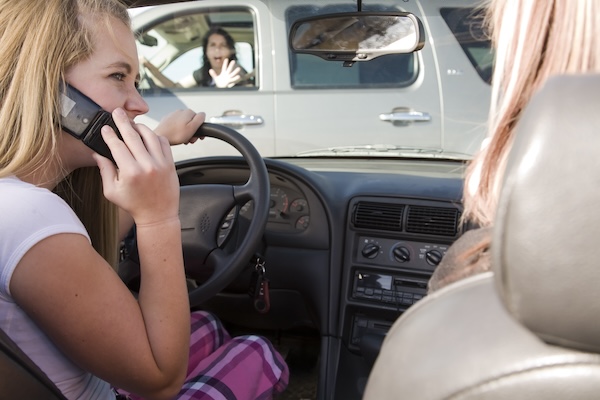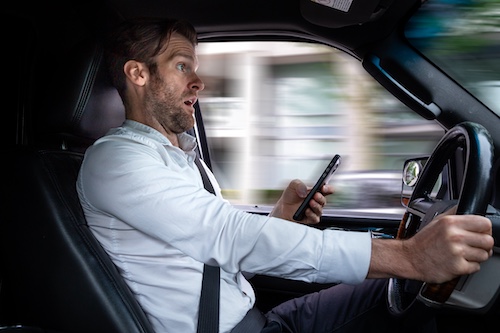Distracted Driving: Understanding Its Impact on Car Accident Claims
At The Super Lawyer, we are dedicated to providing exceptional legal representation for individuals who have been injured in accidents caused by distracted drivers. With a team of experienced attorneys, we specialize in helping clients navigate the complexities of personal injury claims and ensuring they receive the maximum compensation for their losses. Our commitment to justice, combined with our in-depth knowledge of the law, allows us to advocate effectively for victims of distracted driver accidents.
Distracted driving is one of the leading causes of car accidents in the United States, contributing to thousands of crashes, injuries, and fatalities each year. As drivers become more engaged with smartphones, in-car technology, and other distractions, the risks on the road increase significantly.
In this blog, we will explore how distracted driving impacts liability in car accident claims, the legal consequences for at-fault drivers, and why working with an experienced distracted driving accident attorney can help victims secure the compensation they deserve.
Understanding Distracted Driving
Distracted driving is a leading cause of car accidents in the United States. It occurs when a driver’s attention is diverted from the primary task of driving, increasing the risk of a crash.
What is Distracted Driving?
Distracted driving refers to any activity that takes a driver’s focus off the road. This includes texting, talking on the phone, eating, or using a navigation system. These distractions divert a driver’s attention from the primary task of driving, significantly raising the risk of traffic accidents.
Types of Distractions
There are three main types of distractions that can affect a driver’s attention: cognitive, manual, and visual.
- Cognitive distraction occurs when the driver’s mind is not focused on the road, such as when thinking about something unrelated to driving.
- Manual distraction happens when a driver takes their hands off the wheel to engage in tasks like eating or adjusting the radio.
- Visual distraction happens when a driver looks away from the road, such as checking a text message or looking at a navigation screen.
The Impact of Cell Phones
Cell phones are a major source of distracted driving accidents. Texting while driving is particularly dangerous because it combines all three types of distractions—manual, cognitive, and visual. Drivers who engage in cell phone use are far more likely to cause serious injuries or property damage in car accidents.
Young Drivers and Distraction
Young people are at a higher risk for being distracted drivers. They tend to use cell phones and engage in other distractions more frequently than older drivers. This increases the likelihood of accidents, especially among teenagers and young adults. It is important for young drivers to be educated about the dangers of distracted driving and its legal consequences.
Legal Consequences of Distracted Driving
Distracted drivers can be held liable for accidents they cause. If a driver is found to be texting or using their phone at the time of a crash, they may face both civil and criminal penalties. Victims of distracted driving accidents can pursue claims for compensation for medical expenses, lost wages, and property damage.
Understanding the risks and consequences of distracted driving is key to reducing accidents on the road. By staying focused on driving, all drivers can contribute to safer roads and reduce the likelihood of being involved in a car accident.
How Distracted Driving Affects Liability in Car Accidents
Distracted driving plays a crucial role in determining liability in car accident claims. Here is how distracted driving can impact who is held responsible in an accident and what evidence is necessary to prove fault.
Distracted Driving and Negligence
Negligence is a key factor in determining liability for car accidents. If a driver is distracted—whether by texting, talking on the phone, or eating—they are not paying full attention to the road. This failure to focus on driving is considered negligent behavior, which can make the distracted driver liable for any resulting accidents or injuries.
Proving Fault in Distracted Driver Accidents
To prove fault in a distracted driving accident, certain evidence is needed. Cell phone records can show if a driver was using their phone at the time of the accident. Witness statements and police reports also play a role in establishing what happened during the crash. Additionally, video evidence from traffic cameras or dash cams can help support claims of distracted driving.
The Role of Insurance Companies
Insurance companies assess accidents based on the available evidence. If a distracted driver is found to be at fault, the insurance company may be required to pay for damages, medical expenses, and lost wages for the victim. However, the insurer may also try to deny liability, especially if the evidence of distraction is unclear. In such cases, working with a distracted driving accident lawyer can help ensure that victims receive the compensation they deserve.
Liability for Property Damage and Serious Injuries
Distracted driving accidents can result in significant property damage and serious injuries. When a distracted driver is at fault, they can be held liable for both the physical injuries sustained by the victims and the damage to their vehicles. Compensation can also cover the costs of medical treatment, rehabilitation, and lost wages due to injuries from the crash.
The Impact of Distracted Driving on Legal Consequences
Distracted driving can lead to both civil and criminal penalties. In civil cases, the at-fault driver may be required to pay compensation for the damages caused by their distraction. In some cases, particularly if the driver was texting or using their phone illegally, criminal charges may also apply. A distracted driving accident attorney can help victims navigate these complex legal issues.
Understanding how distracted driving affects liability in car accidents is essential for anyone involved in a crash. Whether through evidence or legal representation, victims of distracted driving accidents can pursue the compensation they are entitled to.
The Legal Process for Distracted Driving Accident Claims
Filing a distracted driving accident claim involves several steps that help ensure victims receive fair compensation. Understanding this process can provide clarity and improve the chances of a successful outcome.
Initial Steps After an Accident
Immediately after a distracted driving accident, the first step is to ensure safety and call for medical help if necessary. Gathering evidence is crucial at this stage. This includes taking photos of the scene, obtaining witness statements, and requesting a police report. If possible, obtain the at-fault driver’s cell phone records to support the claim that they were distracted at the time of the crash.
Hiring a Distracted Driving Accident Lawyer
A distracted driving accident lawyer plays a critical role in guiding the victim through the legal process. They can help collect important evidence, such as video evidence, and work with accident reconstruction experts if needed. A lawyer ensures that all legal documents are properly filed and provides the necessary expertise to build a strong case.
Investigation and Evidence Collection
To support a claim, a thorough investigation is necessary. This may include reviewing event data recorders from vehicles, analyzing witness statements, and examining cell phone records. Gathering this evidence helps prove the driver’s distraction and establish their liability in the accident.
Negotiating with Insurance Companies
Once all evidence is gathered, the next step is to present the claim to the insurance company. Insurance companies may offer a settlement, but it is important to evaluate whether it covers all damages, including medical expenses, lost wages, and property damage. A distracted driving accident attorney can negotiate on behalf of the victim to ensure a fair settlement is reached.
Filing a Lawsuit
If the insurance company refuses to offer a fair settlement, the next option is to file a lawsuit. A distracted driving accident lawyer will handle the legal paperwork and represent the victim in court. This step may be necessary if the insurance company disputes liability or offers an insufficient amount of compensation.
Compensation for Damages
Victims of distracted driving accidents can seek compensation for a range of damages. This includes physical injuries, emotional distress, medical expenses, and lost wages. In cases involving severe injuries or fatalities, victims or their families may pursue additional compensation for pain and suffering.
Navigating the legal process for distracted driving accidents requires careful attention to detail. With the help of an experienced distracted driver accident attorney, victims can ensure they receive the compensation they deserve.
Legal Consequences for Distracted Drivers
Distracted driving carries serious legal consequences for those who fail to stay focused on the road. These consequences can range from fines to criminal charges and civil liability for damages.
Civil Liability for Damages
Distracted drivers who cause accidents are often held liable for the damages they cause. This includes property damage, serious injuries, and medical expenses resulting from the crash. In some cases, victims may also seek compensation for lost wages and pain and suffering. A distracted driver accident attorney can help victims pursue compensation from the responsible driver.
Criminal Penalties for Distracted Driving
In some states, distracted driving is treated as a criminal offense. If the driver is found to be texting or using a phone while driving, they may face fines, points on their driving record, or even jail time in severe cases. Criminal charges may be pursued if the accident results in serious injury or death. These penalties are separate from any civil liability for damages.
License Suspension or Revocation
Many states impose penalties that include license suspension or revocation for drivers caught engaging in distracted driving. A distracted driver who is repeatedly caught texting, talking on the phone, or engaging in other distractions may face a longer suspension period or even permanent revocation of their driving privileges.
Impact on Insurance Rates
Distracted drivers who are at fault in an accident can also see an increase in their insurance premiums. Insurance companies often raise rates for drivers with a history of distracted driving, especially if it leads to an accident. This financial impact can last for years, making it even more costly for the driver to maintain coverage.
Impact of Distracted Driving Laws
As states pass stricter laws to curb distracted driving, the legal consequences for those who engage in it continue to grow. Many states have passed laws that specifically address the dangers of texting while driving and other forms of mobile phone use behind the wheel. These laws are designed to reduce accidents and hold distracted drivers accountable for their actions.
Distracted driving can have significant legal and financial consequences. Drivers who cause accidents while distracted can face civil suits, criminal charges, and increased insurance costs, making it crucial to stay focused and avoid distractions while driving.
Consult With an Experienced Distracted Driving Accident Lawyer ASAP!
If you or a loved one has been injured in a distracted driving accident, navigating the legal process can be overwhelming. At The Super Lawyer, our team of experienced distracted driving accident attorneys is here to guide you every step of the way. We understand the challenges you face and are committed to helping you secure the compensation you deserve for your medical expenses, lost wages, and pain and suffering.
Contact us at 404-574-4308 for a free case consultation today!






